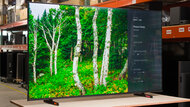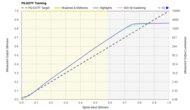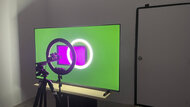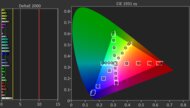Hisense has grown in popularity over the years, and we've written over 40 Hisense TV reviews after buying and testing their models. Even though they started as more of a budget company, they're now competing with bigger brands. Hisense TVs offer great value for their price, so you won't break the bank buying one. Many of their models even feature advanced gaming capabilities, including HDMI 2.1 bandwidth and variable refresh rate (VRR) support, which allows them to compete with more expensive offerings from other brands in terms of features. However, their TVs can also suffer from problems like bugs, uniformity, and quality control issues. You can find our picks for the best Hisense models below. You can also vote on which Hisense models you want us to buy and test. To learn more about Hisense's current TVs, check out our 2025 TV lineup page.
Updates
- 11/21/2025Hisense 98QD5QG reviewed
- 11/12/2025Hisense 100U8QG reviewed
- 09/24/2025Hisense A7N updated
- 09/24/2025Hisense QD7N updated
- 09/12/2025Hisense QD6QF reviewed
Quick Look





We buy and test dozens of TVs yearly, taking an objective, data-driven approach to deliver results you can trust. Our testing process is complex, with hundreds of individual tests that take over a week to complete. Most of our tests are done with specially designed test patterns that mimic real content, but we also use the same sources you have at home to ensure our results match the real-world experience. We use two main tools for our testing: a Colorimetry Research CR-100 colorimeter and a CR-250 spectroradiometer.
-
Best Hisense TV
 Mixed Usage8.4Home Theater8.5Bright Room8.7Sports8.3Gaming8.3Brightness9.2Black Level8.7Color8.4Processing (In Development)7.5Game Mode Responsiveness7.6Resolution4kNative Refresh Rate165HzScreen FinishGlossyPanel TypeLEDSub-TypeVASee all our test resultsDolby VisionYes
Mixed Usage8.4Home Theater8.5Bright Room8.7Sports8.3Gaming8.3Brightness9.2Black Level8.7Color8.4Processing (In Development)7.5Game Mode Responsiveness7.6Resolution4kNative Refresh Rate165HzScreen FinishGlossyPanel TypeLEDSub-TypeVASee all our test resultsDolby VisionYesThe Hisense U8QG is one of the best Hisense TVs we've tested. It's packed with modern features, so whether you're a movie fan looking for Dolby Vision, HDR10+, and DTS audio support, or a gamer seeking high frame rates, you're completely covered. It has three HDMI 2.1 ports that support 4k @ 165Hz and 1080p @ 288Hz with VRR, so you're totally covered if you own a modern console, and you have options if you're a PC gamer. It even features a USB-C port that can be used as an alternative display port, but unfortunately, VRR and 1080p @ 288Hz are not supported when using it, so it's best to utilize the HDMI ports. As feature-packed as this model is, it has relatively slow pixel response times, so fast motion appears a bit blurry and lacks sharpness.
Not only does the TV offer a wide variety of features, but it also has great picture quality overall. The TV has superb contrast, displaying incredibly deep blacks. There's a slight blooming effect around highlights and subtitles when they're displayed against a dark background, but it's subtle and not noticeable in most scenes. This is also one of the brightest models on the market, so highlights stand out in HDR, and it overcomes glare in very bright rooms. It doesn't perform the best when handling direct reflections, so it's best to avoid placing the TV directly opposite a window or lamp for optimal visibility. Colors are very vibrant and have solid accuracy out of the box. However, the TV drastically overbrightens HDR content, so all HDR scenes don't look the way they should.
-
Best Mid-Range Hisense TV
 Mixed Usage8.0Home Theater8.0Bright Room8.4Sports8.0Gaming7.8Brightness8.9Black Level8.1Color7.9Processing (In Development)7.0Game Mode Responsiveness7.3Resolution4kNative Refresh Rate165HzScreen FinishGlossyTypeLEDSub-TypeVASee all our test resultsDolby VisionYes
Mixed Usage8.0Home Theater8.0Bright Room8.4Sports8.0Gaming7.8Brightness8.9Black Level8.1Color7.9Processing (In Development)7.0Game Mode Responsiveness7.3Resolution4kNative Refresh Rate165HzScreen FinishGlossyTypeLEDSub-TypeVASee all our test resultsDolby VisionYesThe best mid-range Hisense TV we've tested is the Hisense U75QG. Despite not having the same caliber of overall picture quality as the Hisense U8QG, it's still a great-looking TV with a ton of features. Like the more expensive option, it supports Dolby Vision, HDR10+, and DTS audio, so movie fans are covered. It even has most of the same gaming features, so you still get 4k @ 165Hz, 1080p @ 288Hz, and VRR. Unlike the U8QG, it doesn't have a USB-C port to use as an alternate display port, but since that port locks you out of using certain features, it's not a big loss at all. Unfortunately, its pixel response times are even slower than those of the top pick, so fast motion appears visibly blurry and lacks clarity.
You don't get the same level of image quality as you do on the higher-end Hisense model, but it's still an impressive-looking TV. Blacks aren't nearly as deep, but the TV still features solid local dimming, which helps blacks appear deeper, making it look good in a dark room. There's a bit more haloing around highlights and subtitles, but it keeps that unwanted glow in check during most scenes. Even though the TV isn't as bright, it's still easily bright enough for most well-lit rooms, and highlights in HDR really stand out. Its handling of direct reflections is a bit worse, so any lights facing the screen are very visible, especially during dark scenes. Colors aren't quite as bright, but they're still punchy enough that the image looks vibrant. Sadly, the TV overbrightens HDR content like the U8QG does.
-
Best Budget Hisense TV
 Mixed Usage7.2Home Theater7.2Bright Room7.6Sports7.6Gaming7.4Brightness7.3Black Level7.1Color7.5Processing (In Development)6.8Game Mode Responsiveness7.7Resolution4kNative Refresh Rate144HzScreen FinishGlossyTypeLEDSub-TypeVASee all our test resultsDolby VisionYes
Mixed Usage7.2Home Theater7.2Bright Room7.6Sports7.6Gaming7.4Brightness7.3Black Level7.1Color7.5Processing (In Development)6.8Game Mode Responsiveness7.7Resolution4kNative Refresh Rate144HzScreen FinishGlossyTypeLEDSub-TypeVASee all our test resultsDolby VisionYesIf you're on a tighter budget, the Hisense U65QF offers great value compared to similarly priced models from other brands. Even though it doesn't provide the same level of image quality as the Hisense U75QG, you still get a ton of modern features like two HDMI 2.1 ports, 4k @ 144Hz, and VRR. It doesn't support 4k @ 165Hz or 1080p @ 288Hz like the higher-end models do, but it actually has faster pixel response times than the U75QG, so fast motion is a bit clearer on this model. Although it's a bit lighter on gaming features, it still supports HDR10+, Dolby Vision, and DTS audio, making it a great choice for movie fans on a tight budget.
What really makes this model stand out in the budget market is its local dimming, so even though blacks aren't as bold as they are on the U75QG, they're still deep and give the image solid depth. There's more visible haloing since the TV's dimming zones aren't as precise, so you do see some haloing around highlights, especially when they move across the screen. The TV is bright in SDR, but since it has lackluster reflection handling, it's best suited for a room with just a few lights on. Its HDR brightness is just good enough to make highlights pop, and even though colors are a bit more muted on this model, they're still vibrant enough that the image doesn't look dull. Like the other models, it severely overbrightens HDR content, so it goes against the content creator's intent.
-
Best Cheap Hisense TV
 Mixed Usage6.0Home Theater5.8Bright Room6.3Sports6.0Gaming6.2Brightness5.6Black Level4.9Color6.8Processing (In Development)6.3Game Mode Responsiveness6.7Resolution4kNative Refresh Rate60HzScreen FinishGlossyTypeLEDSub-TypeVASee all our test resultsDolby VisionYes
Mixed Usage6.0Home Theater5.8Bright Room6.3Sports6.0Gaming6.2Brightness5.6Black Level4.9Color6.8Processing (In Development)6.3Game Mode Responsiveness6.7Resolution4kNative Refresh Rate60HzScreen FinishGlossyTypeLEDSub-TypeVASee all our test resultsDolby VisionYesIf you want a basic TV and are okay with mediocre image quality, consider the Hisense QD6QF. You won't find many modern gaming features on this model, but it still supports VRR to reduce screen tearing. The TV offers a 1440p @ 120Hz mode for those who prefer frames over resolution, but input lag is unusually high when you do that, so most people are best off sticking to 4k @ 60Hz. Pixel response times are a bit on the slower side, so fast motion is noticeably blurry, but it's not too bad for a cheap model. Fortunately, the TV still has features like Dolby Vision, HDR10+, and DTS audio passthrough, so it has great compatibility when watching content.
Unlike the other Hisense models on this list, it lacks local dimming, which would improve contrast, resulting in a washed-out image in darker scenes. Bright colors appear muted, and dark colors lack richness, but since the TV still displays a wide range of colors, the image doesn't appear dull. Unfortunately, it's too dim in HDR for highlights to truly stand out, so HDR content looks lackluster. The TV is just bright enough to use in a room with a few overhead lights on without being distracted by reflections, but it's not bright enough to handle glare in well-lit rooms. You won't want to get this model for your home theater, or if you care about gaming performance, but if you just need something for casual viewing in a kitchen or bedroom, the TV does the job.
Compared To Other Brands
-
Great value for their price.
Whether you're looking at Hisense's flagship or budget-friendly models, they offer better value than similarly priced options from competitors such as Sony, LG, and Samsung.
-
Good for bright and dark rooms.Hisense's options tend to perform well in both bright and dark environments. They usually have VA panels that display deep blacks, which are bright enough to fight glare in well-lit rooms.
-
Great gaming features.As of 2021, Hisense introduced gaming features like HDMI 2.1 bandwidth and VRR support to some higher-end TVs. Now, their higher-end TVs support up to 4k @ 144Hz, and even their cheaper models have advanced gaming features, like VRR.
-
Narrow viewing angle.Their ULED TVs mostly use VA panels with a narrow viewing angle, so they aren't good choices for wide seating arrangements. They don't use viewing angle technology like Samsung, so the image looks inconsistent from the side.
-
Quality control issues.The biggest downside to Hisense TVs compared to more expensive competitors is the quality control issues. There are often problems with uniformity and color accuracy, and their TVs have more bugs and quirks than models from name brands.
Hisense vs TCL
TCL is Hisense's main competitor. Both brands offer good value in their TVs, with features that are only typically found on higher-end models from the major brands.
Hisense vs Vizio
Like Hisense, Vizio TVs are inexpensive. However, in the past few years, Vizio has released much fewer TVs than Hisense. The TVs they do release lack the contrast and brightness you get from similar Hisense models, so they don't provide the same picture quality and value as Hisense.
Hisense vs LG
Right now, LG and Hisense are offering different values. Hisense's LED TVs are not only cheaper than LG's, but they're also much better overall. However, LG has the most varied OLEDs offered by any manufacturer, and Hisense doesn't offer any OLEDs. Still, even the cheapest LG OLEDs are a bit more expensive than the best Hisense TV, so they're not competing on value.
Hisense vs Samsung
Samsung TVs are typically more expensive than Hisense TVs. That said, Hisense's lower-end and mid-range LEDs provide better picture quality and have more advanced features than Samsung's offerings. Even Hisense's higher-end LEDs generally outperform similar models from Samsung. However, Samsung makes some of the best OLEDs on the market, and Hisense doesn't offer any OLEDs at all.
Hisense vs Sony
Sony has an excellent variety of TVs, including LEDs and OLEDs. Sony TVs tend to have amazing image processing features, which used to be a weakness of Hisense TVs, but they've started to catch up in recent years. However, Sony tends to be more expensive than LG and Samsung, so they're significantly more expensive than a 'budget' brand like Hisense. Like the other major brands, Hisense has the edge in value and quality until you get to Sony's expensive high-end offerings.
Generally speaking, you can't go wrong with a Hisense TV. They offer the best value of any TV brand and perform well in dark and bright environments. There are extra features for gamers, and their smart platform is great. However, our Hisense TV reviews show that they aren't a good choice for wide seating areas due to their narrow viewing angles, and you might run into some quality control issues or bugs after buying your Hisense TV.
2025 Hisense Lineup
At CES 2025, Hisense announced a new MicroLED TV known as the 136MX, starting in a massive 136" size. Not much is known about the TV, but it's one of the first Micro LED models on the market. They also announced the Hisense 116UX TriChroma Mini LED TV. LED TVs currently on the market use a backlight to produce light and then add layers of Quantum Dots, phosphors, or color filters to produce the blue, green, and red lights that make up each pixel on the screen. The 116UX moves away from this, instead using separate red, green, and blue LEDs to produce the backlight. This likely results in better color separation than conventional Mini LED TVs, leading to improved color volume and enhanced light efficiency. It's different from Micro LED displays, though, as the TriColor LEDs aren't dimmable on a per-pixel basis; instead, they use zone dimming like a conventional Mini LED display.
Both TVs are advertised to reach 10,000 nits of peak brightness and can display 95% or more of the BT.2020 color space. Given the technology used and the size of these displays, it's obvious they won't be targeting the average consumer. The 116UX is now available to purchase, but it costs around $30,000, which is out of reach for most people. You can also now purchase the 136MX, but at the time of writing, Best Buy has it listed for $149,999.99, so calling it "expensive" would be an understatement.
The Hisense 2025 TV lineup wouldn't be complete without new iterations of their popular ULED lineup. Their entry-level U6QF adds support for 144Hz and an even brighter experience than 2024's U6N. This enhanced brightness also made its way to the popular U75QG and U8QG models, both of which also add support for 4k @ 165Hz. There's also the updated version of their U9 model, known as the U9QG, which has an advertised peak brightness of 6,500 nits, but there's no release date or additional information on that model yet. The entire ULED lineup also features an increase in dimming zones, designed to further enhance contrast and lighting zone precision. On the budget side of things, there are also new versions of the QD6 and QD7, which offer a few more features than the 2024 models. They've also added a 98-inch QD5 to their lineup. In addition to that are the QD4 and A4, which are 1080p models only available in small sizes.
| Model | Sizes | Backlight Type | Advertised Zones | Resolution | Refresh Rate | Smart OS |
|---|---|---|---|---|---|---|
| 136MX | 136" | Micro LED | N/A | Unknown | Unknown | VIDAA TV |
| 116UX | 116" | TriChroma Mini LED | 3584 | Unknown | Unknown | Google TV |
| U9QG | Unknown | Mini LED | Unknown | 4k | 165Hz | Google TV |
| U8QG | 55", 65", 75", 85", 100" | Mini LED | Up to 5376 | 4k | 165Hz | Google TV |
| U75QG | 55", 65", 75", 85", 100" | Mini LED | Up to 2304 | 4k | 165Hz | Google TV |
| U65QF | 55", 65", 75", 85", 100" | Mini LED | Up to 608 | 4k | 144Hz | Fire TV |
| QD7QF | 50", 55", 65", 75", 85", 100" | LED | N/A | 4k |
50", 55", 65": 60Hz 75", 85", 100": 144Hz |
Fire TV |
| QD6QF | 43", 50", 55", 65", 75", 85", 100" | LED | N/A | 4k | 60Hz | Fire TV |
| QD5QG | 98" | LED | N/A | 4k | 60Hz | Google TV |
| QD4 | 40" | LED | N/A | 1080p | 60Hz | Fire TV |
| A4 | 32", 40", 43" | LED | N/A | 1080p | 60Hz | Fire TV |
Product Naming
Hisense uses a simple naming scheme. Starting with the 2021 Hisense TVs, the flagship ULED lineup has a U in front of the model names, while the entry-level models have an A. The first letter is followed by a number to indicate where it stands in the lineup; the last letter represents the year; Hisense uses H for 2022, K for 2023, and N for 2024. For example, the Hisense U8N is a high-end 2024 model, while the Hisense A6N is an entry-level 2024 model. In 2025, Hisense modified its naming scheme slightly, and the second-to-last letter in the model code for most of its lineup now represents the year, which is 'Q', while the last letter denotes the smart OS. For example, the Hisense U8QG runs Google TV, while the U65QF runs Fire TV.
Hisense has completely different lineups outside of North America. Some of their naming conventions stay the same; the Hisense U8N is also available in the UK but uses a different smart system. Our results for Hisense TVs are only valid for the American models.
Recent Updates
Nov 14, 2025:
Replaced the Hisense A7N with the Hisense QD6QF in the 'Best Cheap' category.
Aug 26, 2025:
Replaced the Hisense U8N with the Hisense U8QG, the Hisense U7N with the Hisense U75QG, and the Hisense U6N with the Hisense U65QF. We also updated the 2025 Hisense Lineup section and tweaked some other text throughout the article for clarity.
Apr 18, 2025:
We updated the '2025 Hisense Lineup' section, mentioned the Hisense U9N in the 'Best Hisense TV' category, and tweaked some text throughout for clarity.
Jan 15, 2025:
We refreshed the TV Lineup Section to include information on the new 2025 Hisense models.
Oct 18, 2024:
We added a 'Best Cheap Hisense TV' category and put the Hisense A7N into that spot.
Conclusion
Overall, Hisense offers something for everybody and generally at a low cost. Their ULED TVs are versatile for any use and have features like HDMI 2.1 bandwidth and variable refresh rate support. Thanks to their VA panels, they generally perform well in dark rooms and become bright enough to combat glare in well-lit environments. However, no company is perfect, and Hisense's TVs can suffer from quality control issues, such as uniformity problems and motion artifacts. You can't go wrong with a Hisense if you don't think that'll bother you. For more detailed information on their models, you can find a list of our recent Hisense TV reviews below. Please note that our scores aren't comparable across different test benches, so the older TVs listed below may score higher than they would today.












